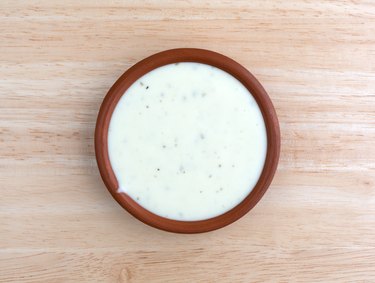
A veggie platter just isn't complete without a dish of creamy ranch dressing. However, there are a lot of calories in most ranch dressings, as well as fat, sodium and sometimes added sugar. Ranch is only healthy if the ingredients used to make it are also healthy.
Tip
Ranch dressing can be healthy if consumed in moderation and made with healthy ingredients.
Video of the Day
Calories in Ranch Dressing
To be delicious, ranch dressing has to be creamy. Therefore it must contain fat, typically in the form of vegetable oil and buttermilk. The fat content among different brands varies, depending on the recipe, but somewhere between 9 and 14 grams of fat per serving is typical, according to USDA data. One serving is only 2 tablespoons.
Video of the Day
Most of the calories in ranch dressing come from fat. With 9 calories per gram, fat is more caloric than protein and carbohydrates, which have 4 calories per gram, according to the USDA. Per serving, ranch fat content can total 100 to 140 calories.
If you are on a calorie-controlled diet for weight loss, you might be eating only 1,200 to 1,500 calories, which the National Institutes of Health says is effective for helping most women lose weight. If the ranch dressing on your lunch salad has 140 calories, that could be more than 10 percent of your daily calorie allotment — just in your dressing.
Saturated Fat, Sodium and Sugar
Some of the fat in ranch dressing is saturated fat. This is the type of fat that the American Heart Association warns can raise your cholesterol and increase your risk of developing cardiovascular disease. The AHA suggests Americans limit their intake of saturated fat to 5 to 6 percent of daily calories.
One serving of ranch contains 2 to 2.5 grams of saturated fat. That's 18 or 19 calories from saturated fat — about 20 percent of the maximum recommended intake for an 1,800-calorie diet. That doesn't seem like much, but again, that's from just 2 tablespoons of salad dressing. If you eat other foods with saturated fat throughout the day, you could easily exceed the AHA's recommendation.
The AHA also has a recommendation for added sugars — no more than 100 calories per day for women and 150 calories for men. You wouldn't think that ranch dressing would contain sugar, but like many salad dressings, it often does. Some don't contain much — about 1 gram — but others may contain 4 grams or more.
With 4 calories per gram, 4 grams of sugar is 36 calories — more than a third of the maximum amount of added sugar the AHA says women should have each day, and more than one-fifth of the maximum amount for men. Too much added sugar in the diet increases the risk of obesity, cardiovascular disease, high blood pressure, obesity-related cancers and cavities, according to a research review published in Translational Medicine in January 2017.
Excess sodium can also affect cardiovascular health, increasing blood pressure and the risk of heart disease. The AHA says 2,300 milligrams of sodium each day is the absolute maximum safe amount for adults; however, an ideal goal is lowering sodium intake below 1,500 milligrams.
Dressings and other condiments are notoriously high in sodium. Just 2 tablespoons of one ranch dressing contains 320 milligrams of the mineral. That's 14 percent of the AHA's maximum limit and 21 percent of the ideal limit.
Read more: 15 Reasons to Kick Sugar
Healthier Ranch Dressing
The good news is you don't have to give up creamy ranch. You just have to be more discerning when reading labels, and look for dressings with no or very little added sugar, low saturated fat and low sodium. However, they won't be easy to find.
A better bet is to make your own, which is surprisingly easy. Start with a base of low-fat, protein-rich Greek yogurt. Most recipes use buttermilk, but it's not necessary. You could add some plain kefir, which is a rich source of probiotics that promote healthy digestion.
Next, add some fresh lemon juice and some parsley, onion powder, dijon mustard and chopped chives. Season with black pepper and a dash of salt, stir well and serve.
- USDA: "Ranch Dressing"
- USDA: "How Many Calories Are in One Gram of Fat, Carbohydrate, or Protein?"
- NIH: "Healthy Eating Plan"
- American Heart Association: "Saturated Fat"
- USDA: "Ranch Dressing."
- American Heart Association: "Added Sugars"
- Translational Medicine: "Obesity and Obesity Related Diseases, Sugar Consumption and Bad Oral Health: A Fatal Epidemic Mixtures"
- American Heart Association: "How Much Sodium Should I Eat per Day?"
- Nutrition Research Reviews: "Milk Kefir: Nutritional, Microbiological and Health Benefits."
- Epicurious: "The Best Buttermilk Substitutes"